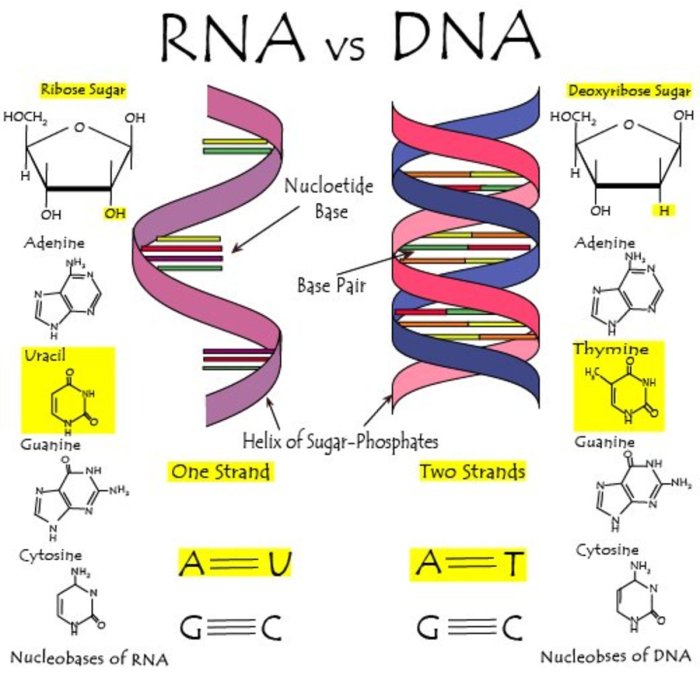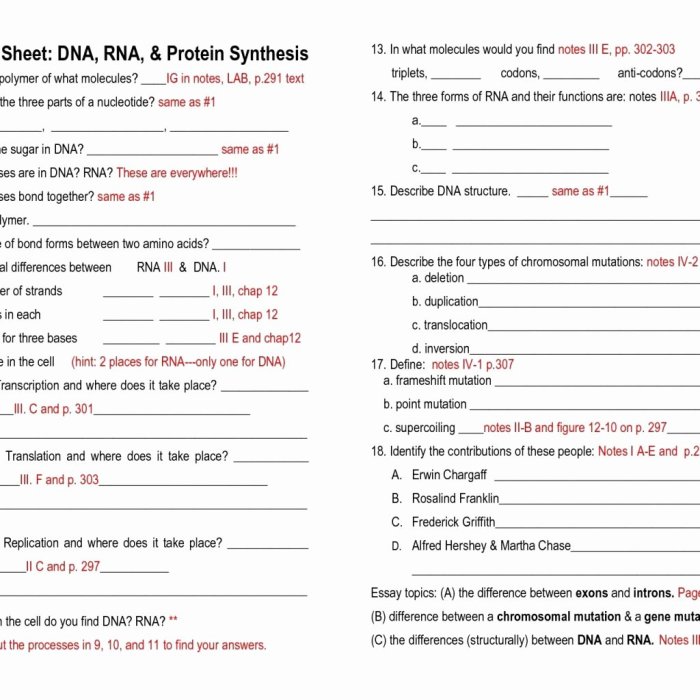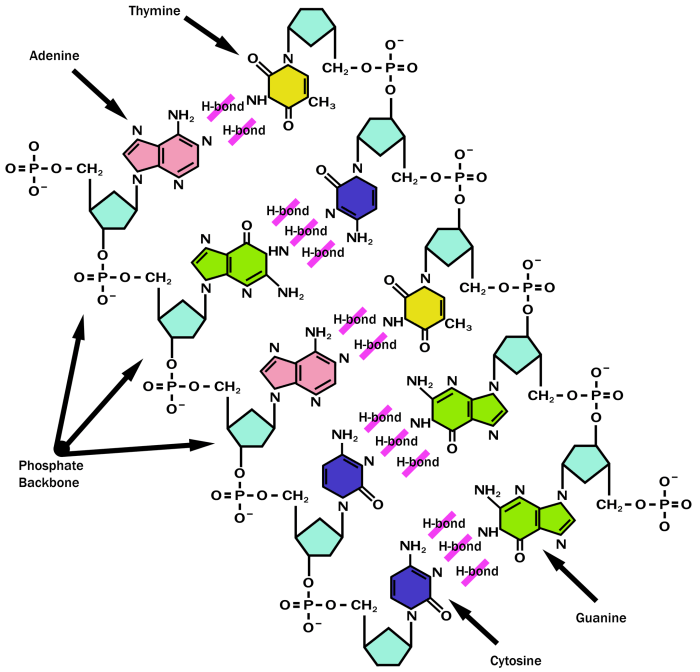Embark on a captivating journey into the realm of molecular biology with our worksheet on DNA and RNA. Dive into the intricate structures, unravel the functions, and explore the processes that govern the flow of genetic information. Prepare to be amazed by the fundamental building blocks of life!
As we delve into the topic, you’ll discover the fundamental differences between DNA and RNA, witness the majestic double-helix structure of DNA, and grasp the crucial roles they play in storing and transmitting genetic information. Get ready to witness the fascinating processes of transcription and translation, where DNA’s blueprints are transformed into the proteins that orchestrate life’s symphony.
Structure of DNA and RNA

DNA and RNA are two essential molecules that play vital roles in the storage and transmission of genetic information. They share a similar chemical structure, but there are also key differences between them.
Basic Structure
Both DNA and RNA are composed of a chain of nucleotides. Each nucleotide consists of a sugar molecule, a phosphate group, and a nitrogenous base. The sugar molecule in DNA is deoxyribose, while in RNA it is ribose. The phosphate group forms the backbone of the chain, while the nitrogenous bases form the rungs of the ladder.
There are four different nitrogenous bases: adenine (A), thymine (T), cytosine (C), and guanine (G). In DNA, A always pairs with T, and C always pairs with G. This is known as the base-pairing rule.
Differences between DNA and RNA
The following table summarizes the key differences between DNA and RNA:
| Characteristic | DNA | RNA |
|---|---|---|
| Sugar molecule | Deoxyribose | Ribose |
| Nitrogenous bases | A, T, C, G | A, U, C, G |
| Base-pairing rule | A-T, C-G | A-U, C-G |
| Shape | Double helix | Single strand |
| Function | Stores genetic information | Carries genetic information and directs protein synthesis |
Illustration of the Double-Helix Structure of DNA
The double-helix structure of DNA was first proposed by James Watson and Francis Crick in 1953. This structure consists of two strands of DNA that are twisted around each other in a spiral shape. The nitrogenous bases are located on the inside of the helix, and they are held together by hydrogen bonds.
The double-helix structure of DNA is essential for its function as a carrier of genetic information.
Function of DNA and RNA

DNA, or deoxyribonucleic acid, and RNA, or ribonucleic acid, are the molecules that carry genetic information in cells. DNA is found in the nucleus of cells, while RNA is found in both the nucleus and the cytoplasm.DNA stores genetic information in the form of genes.
Genes are specific regions of DNA that code for a particular protein. Proteins are the building blocks of cells and are essential for cell function.RNA is involved in protein synthesis. There are three main types of RNA: messenger RNA (mRNA), transfer RNA (tRNA), and ribosomal RNA (rRNA).
mRNA carries the genetic information from DNA to the ribosomes, where proteins are synthesized. tRNA brings the amino acids to the ribosomes in the correct order, as specified by the mRNA. rRNA is a component of the ribosomes and helps to catalyze the formation of peptide bonds between the amino acids.The
flow of genetic information from DNA to RNA to protein can be summarized as follows:
- DNA stores genetic information in the form of genes.
- mRNA carries the genetic information from DNA to the ribosomes.
- tRNA brings the amino acids to the ribosomes in the correct order.
- rRNA helps to catalyze the formation of peptide bonds between the amino acids.
Transcription and Translation: Worksheet On Dna And Rna

The central dogma of molecular biology describes the flow of genetic information from DNA to RNA to proteins. Transcription and translation are the two key processes involved in this flow of information.
Transcription
Transcription is the process by which the genetic information encoded in DNA is copied into a complementary RNA molecule. It occurs in the nucleus of eukaryotic cells and the cytoplasm of prokaryotic cells. The enzyme RNA polymerase binds to the promoter region of a gene and separates the DNA strands.
RNA polymerase then uses one of the DNA strands as a template to synthesize a complementary RNA molecule.
Translation
Translation is the process by which the genetic information encoded in RNA is used to synthesize a protein. It occurs in the cytoplasm of cells. The ribosome binds to the mRNA molecule and reads the codons in the mRNA. Each codon corresponds to a specific amino acid.
The ribosome then assembles the amino acids into a polypeptide chain, which is the primary structure of a protein.
The processes of transcription and translation are essential for the synthesis of proteins, which are the building blocks of cells and are responsible for a wide range of cellular functions.
Diagram of Transcription and Translation, Worksheet on dna and rna
The following diagram shows the steps involved in transcription and translation:
- Transcription:
- RNA polymerase binds to the promoter region of a gene.
- RNA polymerase separates the DNA strands.
- RNA polymerase uses one of the DNA strands as a template to synthesize a complementary RNA molecule.
- Translation:
- The ribosome binds to the mRNA molecule.
- The ribosome reads the codons in the mRNA.
- The ribosome assembles the amino acids into a polypeptide chain.
Replication of DNA

DNA replication is a fundamental process in all living organisms, allowing cells to make copies of their genetic material before cell division. This ensures that each daughter cell receives a complete set of genetic instructions.The replication process is carried out by a complex molecular machinery involving several enzymes and proteins.
Working on a worksheet on DNA and RNA? If you need a quick break, check out how many quarts is 1.6 l and then come back to your worksheet refreshed and ready to learn more about the building blocks of life.
The key enzyme responsible for DNA replication is DNA polymerase, which synthesizes new DNA strands using existing DNA strands as templates.
Role of DNA Polymerase in DNA Replication
DNA polymerase plays a crucial role in DNA replication by adding new nucleotides to the growing DNA strand. It recognizes the correct base pairs (A-T and C-G) and incorporates them into the new strand, ensuring that the genetic information is accurately copied.DNA
polymerase also has proofreading capabilities, meaning it can detect and correct errors that may occur during replication. This helps to maintain the integrity and fidelity of the genetic information.
Key Steps of DNA Replication
The process of DNA replication can be summarized in the following key steps:
- Initiation:The replication process begins at specific locations called origins of replication, where the DNA double helix unwinds and separates.
- Elongation:DNA polymerase binds to the unwound DNA and begins synthesizing new DNA strands in the 5′ to 3′ direction, using the existing strands as templates.
- Proofreading:As DNA polymerase synthesizes the new strands, it checks for errors and corrects any mismatched nucleotides.
- Termination:Replication continues until the entire DNA molecule is copied. The newly synthesized strands are then annealed to form a double helix, resulting in two identical copies of the original DNA molecule.
Mutations

Mutations are changes in the DNA sequence of an organism. They can occur spontaneously or be caused by environmental factors such as radiation or chemicals. Mutations can have a wide range of effects, from being harmless to causing serious genetic diseases.
Types of Mutations
There are many different types of mutations, but the most common are:
- Point mutations: These are changes in a single nucleotide base pair. They can be caused by errors during DNA replication or by exposure to mutagens.
- Insertions: These are additions of one or more nucleotide base pairs to the DNA sequence. They can be caused by errors during DNA replication or by the insertion of transposable elements.
- Deletions: These are deletions of one or more nucleotide base pairs from the DNA sequence. They can be caused by errors during DNA replication or by the deletion of transposable elements.
Effects of Mutations
The effects of mutations can vary depending on the type of mutation and the location of the mutation in the DNA sequence. Some mutations are harmless, while others can cause serious genetic diseases. For example, point mutations in the gene that codes for the protein beta-globin can cause sickle cell anemia, a genetic disease that affects the shape of red blood cells.
Q&A
What is the primary function of DNA?
DNA serves as the blueprint for life, storing the genetic information that determines an organism’s traits.
How does RNA differ from DNA?
RNA is single-stranded, while DNA is double-stranded. RNA also contains the sugar ribose instead of deoxyribose and uracil instead of thymine.
What is the role of transcription in gene expression?
Transcription converts the genetic information in DNA into a messenger RNA (mRNA) molecule, which carries the instructions to the ribosomes for protein synthesis.
